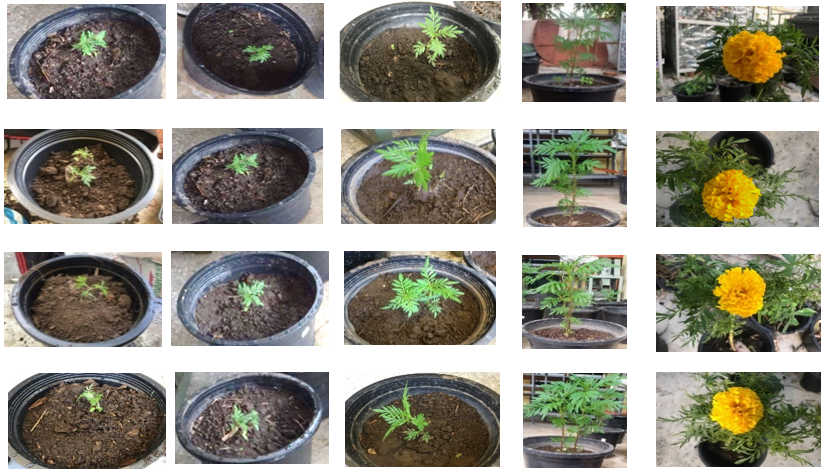ผลของปริมาณกลีเซอรอลต่อสมบัติทางกายภาพและทางกลของฟิล์มย่อยสลายได้จากแป้งมันเทศเพื่อผลิตถุงเพาะชำ
Main Article Content
บทคัดย่อ
บทคัดย่อ
งานวิจัยนี้มีวัตถุประสงค์เพื่อศึกษาผลของการใช้กลีเซอรอลเป็นพลาสติกไซเซอร์ต่อสมบัติทางกายภาพ และทางกลของฟิล์มย่อยสลายได้ตามธรรมชาติจากแป้งมันเทศเพื่อผลิตถุงเพาะชำ เตรียมฟิล์มโดยการละลายแป้งมันเทศในน้ำให้มีความเข้มข้นร้อยละ 5 โดยน้ำหนัก และศึกษาผลของปริมาณกลีเซอรอล 5 ระดับ คือ ร้อยละ 0, 25, 50, 75 และ 100 โดยน้ำหนักของแป้ง ขึ้นรูปแผ่นฟิล์มโดยการทำแห้งที่ 60 องศาเซลเซียส นาน 24 ชั่วโมง พบว่าแผ่นฟิล์มมีความหนาอยู่ในช่วง 0.36-0.39 มิลลิเมตร ค่า aw ของแผ่นฟิล์มอยู่ระหว่าง 0.40-0.47 การละลายน้ำ อัตราการซึมผ่านไอน้ำ และความอ่อนนุ่มเพิ่มขึ้นตามปริมาณกลีเซอลรอลที่เพิ่มสูงขึ้น ส่วนค่าการต้านทานแรงดึงและค่าต้านทานแรงเจาะของฟิล์มแป้งมันเทศเพิ่มขึ้นเมื่อปริมาณของกลีเซอรอลลดลง ผลทดสอบการย่อยสลายโดยการฝังในดินลึกประมาณ 8-10 เซนติเมตร พบว่าฟิล์มสามารถย่อยสลายได้ร้อยละ 100 ในระยะเวลา 3 สัปดาห์ โดยฟิล์มแป้งมันเทศที่ผสมกลีเซอรอลร้อยละ 50 มีผลการทดสอบโดยรวมดีที่สุด
Article Details
บทความที่ได้รับการตีพิมพ์เป็นลิขสิทธิ์ของ วารสารวิทยาศาสตร์และเทคโนโลยี มหาวิทยาลัยอุบลราชธานี
ข้อความที่ปรากฏในบทความแต่ละเรื่องในวารสารวิชาการเล่มนี้เป็นความคิดเห็นส่วนตัวของผู้เขียนแต่ละท่านไม่เกี่ยวข้องกับมหาวิทยาลัยอุบลราชธานี และคณาจารย์ท่านอื่นๆในมหาวิทยาลัยฯ แต่อย่างใด ความรับผิดชอบองค์ประกอบทั้งหมดของบทความแต่ละเรื่องเป็นของผู้เขียนแต่ละท่าน หากมีความผิดพลาดใดๆ ผู้เขียนแต่ละท่านจะรับผิดชอบบทความของตนเองแต่ผู้เดียว
เอกสารอ้างอิง
[1] Thumthanaruk, B., Pengpoondech, P.
and Rodsuwan, U. 2012. Quality of Tapioca Starch Film Mixed with Jellyfish Protein Hydrolysate. Agricultural Science Journal 43(2): 437-440. (in thai)
[2] Abdou, E. S. and Sorour M. A. 2014. Preparation and Characterization of Starch/Carrageenan Edible Films. International Food Research Journal 21(1): 189-193.
[3] Tulamandi, Sreedath. and et al. 2016. A Biodegradable and Edible Packaging Film Based on Papaya Puree, Gelatin, and Defatted Soy Protein. Food Packaging and Shelf Life. 10: 60-71.
[4] Hianik, T. and et al. 2016. Advances in lipid film based biosensors. Trends in Analytical Chemistry. 79: 210-221.
[5] Xie, F. and et al. 2009. Rheological Properties of Starches with Different Amylose/Amylopectin Ratios. Journal of Cereal Science 49: 371–377.
[6] Farhan, A. and Hani, N. M. (2017). Characterization of Edible Packaging Flms Based on Semi-Refined Kappa-Carrageenan Plasticized with Glycerol and Sorbitol. Food Hydrocolloids. 64: 48-58.
[7] Vieira, M. G. A. and et al. 2011. Natural-Based Plasticizers and Biopolymer Films: a Review. European Polymer Journal. 47: 254-263.
[8] Taija, R.A., Roos, H. and Jouppila, K. 2007. Effect of Various Polyols and Polyol Content on Physical and Mechanical Properties of Potato Starch-Based Films. Carbohydrate Polymers. 67: 288-295.
[9] Müller, C. M. O., Yamashita, F. and Laurindo, J. B. 2008. Evaluation of the Effects of Glycerol and Sorbitol
Concentration and Water Activity on the Water Barrier Properties of Cassava Starch Films Through a Solubility Approach. Carbohydrate Polymers. 72: 82-87.
[10] Li, M and Lee T. C. 1996. Effect of Cysteine on the Functional Properties and Microstructure of Wheat Flour Extrudates. Journal of Agricultural and Food Chemistry. 44: 1871-1880.
[11] Jomlapeeratkiul, P., Poomsa-ad, N. and Wiset, L. 2014. The Effects of Drying Temperatures and Oil Contents on Properties of Biodegradable Film from Konjac Flour. Journal of the Thai Society of Agricultural Engineering. 20(2): 1-7. (in thai)
[12] Mathlouthi, M. 2001.Water Content, Water Activity, Water Structure and the Stability of Foodstuffs. Food Control. 12: 409-417.
[13] Sperber, W. H. 1983. Influence of Water Activity on Foodborne Bacteria - A Review. Journal of Food Protection. 46(2): 142-150.
[14] Ekthamasut, K and Akesowan A. 2001. Effect of Vegetable Oils on Physical Characteristics of Edible Konjac Films. AU Journal of Technology. 5: 73-78.
[15] Choi, W. S. and Jung H. H. 2001. Physical and Mechanical Properties of Pea-Protein-Base Edible Film. Journal Food Science. 66(2): 319-322.
[16] Tsou, C. H. and et al. 2014. Preparation and Characterization of Bioplastic-Based Green Renewable Composites from Tapioca with Acetyl Tributyl Citrate as a Plasticizer. Materials. 7: 5617-5632.
[17] Riku, A.T. and et al. 2007. Effect of Various Polyols and Polyol Contents on Physical and Mechanical Properties of Potato Starch-Based Films. Carbohydrate Polymers. 67: 288-295.
[18] Alves, V. D. and et al. 2007. Effect of Glycerol and Amylose Enrichment on Cassava Starch Film Properties. Journal of Food Engineering. 78: 941-946.
[19] Noiduang, P., Thawla, L. and Pa-ai, O. 2015. Study on Edible Film Production from Chinese Water Chestnuts Starch. Agricultural Science Journal. 46(3): 665-668.
(in thai)
[20] Gontard, N., Guillbert, S. and Cuq, J. L. 1993. Water and Glycerol as Plasticizers Affect Mechanical and Water Vapour Barrier Properties of an Edible Film. The Journal of Food Science. 55(1): 206-211.
[21] Mali, S. and et al. 2006. Effects of Controlled Storage on Thermal, Mechanical and Barrier Properties of Plasticized Films from Different Starch Sources. Journal of Food Engineering. 75: 453-460.
[22] Veiga, S. P. 2007. Sucrose and Inverted Sugar as Plasticizer. Effect on cassava Starch-Gelatin Film Mechanical Properties Hydrophilicity and Water Activity. Food Chemistry. 103: 255-262.
[23] Chillo, S. and et al. 2008. Influence of Glycerol and Chitosan on Tapioca Starch-Based Edible Film Properties. Journal of Food Engineering. 88: 159-168.
[24] Mali, S. and et al. 2005. Water Sorption and Mechanical Properties of Cassava Starch Films and Their Relation to Plasticizing Effect. Carbohydrate Polymers. 60: 283-289.
[25] Seo, J. and et al. 2016. Step-Reduced Synthesis of Starch-Silver
Nanoparticles. International Journal of Biological Macromolecules. 80: 126-128.
[26] Melo, C. P. B. and et al. 2011. Effect of Manufacturing Process and Xanthan Gum Addition on the Properties of Cassava Starch Films. Journal Polymer Environment. 19:739-749.


